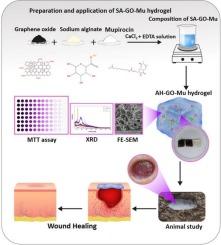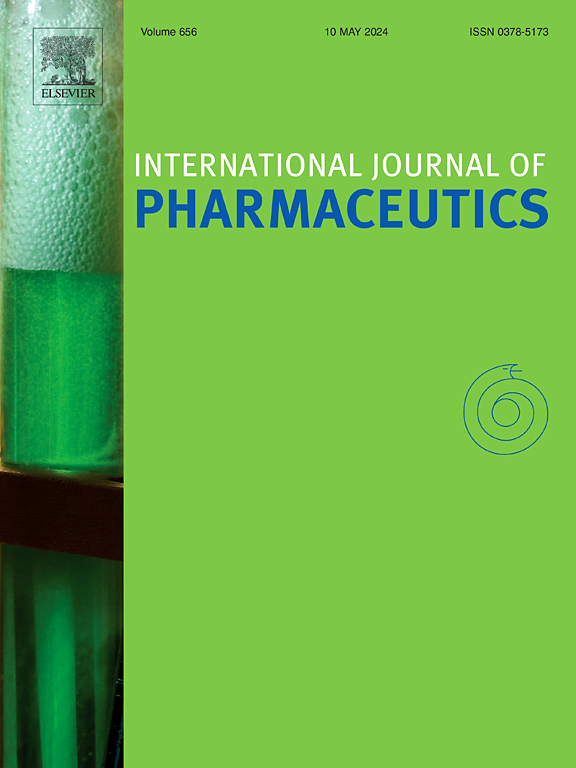A new efficient skin dressing based on sodium alginate − graphene oxide bionanocomposite hydrogel to expedite wound healing process
IF 5.2
2区 医学
Q1 PHARMACOLOGY & PHARMACY
引用次数: 0
Abstract
Wound management remains challenging due to the complex and multi-stage nature of healing process, making the selection of appropriate dressings critical for preventing infection and promoting tissue regeneration. In this study, an alginate–graphene oxide–mupirocin bionanocomposite hydrogel was developed as a multifunctional skin dressing to accelerate wound healing and provide antibacterial protection. The process involved the synthesis of graphene oxide followed by the preparation of graphene oxide and mupirocin-loaded sodium alginate hydrogels. Comprehensive structural characterizations were carried out using DLS, FTIR, FE-SEM, XRD, and TGA techniques. The hydrogel exhibited a highly porous structure, favorable for drug loading and water uptake, and demonstrated structural stability over a six-month storage period. Physicochemical and biological properties including swelling behavior, mechanical integrity, sustained drug release (up to 52 h), antibacterial activity, hemocompatibility, and cytocompatibility were systematically evaluated. The hydrogel effectively inhibited Staphylococcus aureus growth in vitro. Biocompatibility was confirmed through cell viability assays using L929 mouse fibroblasts and HU02 human fibroblasts, while hemocompatibility was assessed via hemolysis testing. In vivo studies demonstrated that the hydrogel markedly enhanced wound closure, attenuated inflammation, and facilitated tissue regeneration, resulting in complete healing within 16 days. These results highlight the potential of this bionanocomposite hydrogel as a promising platform for advanced wound care applications.

一种基于海藻酸钠-氧化石墨烯生物复合水凝胶的新型高效皮肤敷料,加速伤口愈合过程。
由于愈合过程的复杂性和多阶段性,伤口管理仍然具有挑战性,因此选择合适的敷料对于预防感染和促进组织再生至关重要。在这项研究中,海藻酸盐-氧化石墨烯-莫匹罗星生物纳米复合水凝胶被开发成一种多功能皮肤敷料,可以加速伤口愈合并提供抗菌保护。该工艺包括氧化石墨烯的合成,然后制备氧化石墨烯和负载莫匹罗辛的海藻酸钠水凝胶。采用DLS、FTIR、FE-SEM、XRD、TGA等技术对其进行了全面的结构表征。该水凝胶具有高度多孔结构,有利于药物的装载和水的吸收,并且在6个月的储存期内表现出结构稳定性。系统评估其理化和生物学特性,包括肿胀行为、机械完整性、药物持续释放(高达52 h)、抗菌活性、血液相容性和细胞相容性。水凝胶能有效抑制金黄色葡萄球菌的体外生长。通过L929小鼠成纤维细胞和HU02人成纤维细胞的细胞活力测定来确定生物相容性,同时通过溶血试验来评估血液相容性。体内研究表明,水凝胶显著增强伤口愈合,减轻炎症,促进组织再生,在16 天内完全愈合。这些结果突出了这种生物纳米复合水凝胶作为先进伤口护理应用的有前途的平台的潜力。
本文章由计算机程序翻译,如有差异,请以英文原文为准。
求助全文
约1分钟内获得全文
求助全文
来源期刊
CiteScore
10.70
自引率
8.60%
发文量
951
审稿时长
72 days
期刊介绍:
The International Journal of Pharmaceutics is the third most cited journal in the "Pharmacy & Pharmacology" category out of 366 journals, being the true home for pharmaceutical scientists concerned with the physical, chemical and biological properties of devices and delivery systems for drugs, vaccines and biologicals, including their design, manufacture and evaluation. This includes evaluation of the properties of drugs, excipients such as surfactants and polymers and novel materials. The journal has special sections on pharmaceutical nanotechnology and personalized medicines, and publishes research papers, reviews, commentaries and letters to the editor as well as special issues.

 求助内容:
求助内容: 应助结果提醒方式:
应助结果提醒方式:


